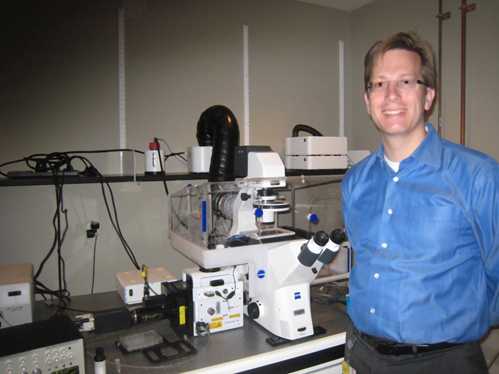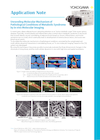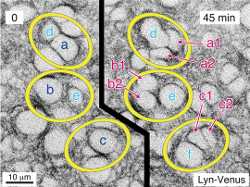Live Confocal Microscopy
Live-cell imaging experiments can be major technical challenges. Since widely variable microscope stage conditions often dictate an experiment’s failure or success, it is imperative for imaging technologies to be efficient, accurate, and non-invasive.
Spinning Disk Confocal Microscopy Technology from Yokogawa
Maximum Results. Maximum Reliability.
After more than 25 years of industry expertise in Microlens-Enhanced Spinning Disk Technology, Yokogawa has created a wide portfolio of confocal scanners, including a super-resolution scanner, providing researchers with powerful magnified imaging solutions and technologies that maximize high-speed live-cell imaging while minimizing phototoxicity and photobleaching.
Using a proprietary Microlens-Enhanced Dual Spinning Disk design, Yokogawa’s Spinning Disk Confocal Scanner Units (CSUs) transform optical microscopes by enabling real-time live-cell imaging.
-
Super Resolution
Optimize results with the CSU-W1 SoRa Confocal Scanner.
-
Wide Field of View
Improve efficiency with the CSU-W1 Confocal Scanner.
-
High Speed
Get next level turnarounds with the CSU-X1 Confocal Scanner.
-
Uniformizer
A flat-top beam shaper option for CSU-W1.
Details

Comparison of Spinning Disk Confocal (CSU) series
| Model | CSU-W1 | CSU-X1 | ||||
|---|---|---|---|---|---|---|
| High-end | Basic | |||||
| Imaging Speed (Max. fps) |
200 | 2,000 | 360 | |||
| Scanner Motor Rotation Speed (rpm) |
1,500-4,000 | 1,500-10,000 (Variable) |
1,800 (Fixed)*2 |
|||
| Recommended camera exposure time |
5msec | 0.5msec | 33msec | |||
| Effective FOV | 17x16mm | 10x7mm | ||||
| Disk unit | Selectable up to 2 disks Pinhole size :50µm, 25µm |
1 disk Pinhole size :50µm |
||||
| Rotation position trigger signal |
External signal output possible | None*2 | ||||
| Filters | EX | Option | ||||
| DM | Option (up to 3 filters) | Option (1 filter) |
||||
| EM | Option (up to 10 filters with filter wheel) |
Option (up to 12 filters with filter wheel) |
Option (1 filter) |
|||
| Addition or exchange of filters |
At user site :DM block and filters (EX, EM.) At Yokogawa factory :DM |
|||||
| *1 option | ||||||
Comparison between CSU and other confocal systems
| Model | CSU | Conventional Point-scan Confocal |
Conventional Slit-scan Confocal |
Other spinning disk Confocal |
Epi- fluorescence (Wide field) |
|---|---|---|---|---|---|
| Scan Type | Microlens-enhanced multi beam scan |
Single beam scan | Line Scan | Disk scan (Multi beam or slit) | None |
| Light Source | Lasers | Hg or Xenon arc lamp | |||
| Detector | CCD, EMCCD | PMT | Line CCD | CCD, EMCCD | |
| Microscope | Flexible | Specific | Flexible / Specific | Flexible | |
| Scan speed of full-size image |
2000fps | ~1fps | ~120fps (512X512) | <200fps | Any |
| Photo bleaching/ photo toxicity |
Low | Severe | Low | ||
| Confocality | High (X-Y-Z confocal) | Modest (Compromise y-resolution) |
Modest (X-Y-Z confocal with pinhole, Compromise y-resolution with slit-scan) |
None | |
| Image Quality (Background) |
High Good S/N (Low background) |
High (multiple averaging necessary) |
Modest | Modest (High background with dim samples) |
Low (High background) |
User labs
- Ted Salmon Lab., Dept. of Biology, University of North Carolina, Chapel Hill
- Waterman-Storer Lab., Laboratory of Cell and Tissue Morphodynamics (LCTM),NHLBI(Bethesda Campus)
- Tim Mitchison Lab., Dept. of Systems Biology, Harvard Medical School
- Scholey Lab., Dept. of Cell and Computational Biology, University of California, Davis
- The Vale Lab., Dept. of Cellular and Molecular Pharmacology, University of California, San Francisco
- The Wadsworth Lab., Biology Dept., University of Massachusetts, Amherst
- The Kiehart Lab., Dept. of Biology, Duke University
- HSC Core Facilities School of Medicine, University of Utah
- Indiana Center for Biological Microscopy, Indiana University Medical Center
- Ehlers Laboratory - Department of Neurobiology, Duke University
- Bob Goldstein Lab., University of North Carolina Chapel Hill
- Andrew Matus Lab., at Friedrich Miescher Institute for Biomedical Research
- Laboratory of Developmental Dynamics,Graduate School of Life Sciences, Tohoku University
- Zena Werb Lab., Anatomy, University of California San Francisco
- Satoshi Nishimura Lab., Dept. of Cardiovascular Medicine, the University of Tokyo
- Oshima Lab., Graduate School of Interdisciplinary Information Studies,The Univ. of Tokyo
- The Huser research group at UC Davis
- Nakano Lab., Graduate School of Science, University of Tokyo
Sites and Textbooks
1) Microscopy & Imaging Resources on the WWW
Complete list of all aspects of microscopy and imaging, by Douglas W. Cromey From Cellular Imaging Core of Southwest Environmental Health Sciences Center, University of Arizona College of Pharmacy, University of Arizona
2) The Centro de Biologia Molecular “Severo Ochoa” (CBMSO)
Contains links to general information, microscopy laboratories, publications, courses and meetings, societies, images. Especially useful for finding microscopy workshops.
3) The Cell Imaging Facility, a part of the University of Utah Health Science Center's Core Research Facilities Department
Good explanation of CSU-Disk scanning confocal system by Chris Rodesch
4) Molecular Expressions Website
Run by National High Magnetic Field Laboratory, Florida State University.
One of Web's largest collections of excellent optical microscopy images, and quite thorough information on all types of microscopy.
Interactive Java Tutorials sponsored by Nikon (Nikon MicroscopyU) and Olympus(Olympus Microscopy Resource Center) are extremely useful to learn not only confocal but all kinds of microscopies, and related technologies.
Life Science Textbooks
|
Microscopy Techniques, Advances in Biochemical Engineering/Biotechnology Vol.95 |
|
|
Confocal Microscopy for Biologists |
|
|
Live Cell Imaging, A Laboratory Manual |
|
|
Handbook of Biological Confocal Microscopy, 3rd Edition |
|
|
VideoMicroscopy, The Fundamentals ISBN: 0-306-45531-5
|
|
|
Direct-View High-Speed Confocal Scanner: The CSU-10, Chapter 2: Cell Biological Applications of Confocal Microscopy (Methods in Cell Biology) |
Articles: Microlens-Enhanced Spinning Disk Technology and its applications
| Quantification and clustering of actin cytoskeletal structures in plant cells: role of actin bundling in stomatal movement during diurnal cycles in Arabidopsis guard cells. Higaki T, Kutsuna N, Sano T, Kondo N, Hasezawa S submitted. |
| Current Application and Technology of Functional Multineuron Calcium Imaging. Shigehiro Namiki and Yuji Ikegaya Biological and Pharmaceutical Bulletin Vol.32(2009) , No.11 |
| Live imaging of yeast Golgi cisternal maturation. Kumi Matsuura-Tokita, Masaki Takeuchi, Akira Ichihara, Kenta Mikuriya and Akihiko Nakano Nature 441, 1007-1010 (22 June 2006) |
| Performance comparison between the high-speed Yokogawa spinning disc confocal system and single-point scanning confocal systems. E. Wang, C. M. Babbey & K. W. Dunn Journal of Microscopy, Vol. 218, Pt 2 May 2005, pp. 148 ?159 |
| Optically sectioned fluorescence lifetime imaging using a Nipkow disk microscope and a tunable ultrafast continuum excitation source. D.M.Grant, D.S. Elson, D.Schimpf, C.Dunsby, J.Requejo-Isidro, E.Auksorius, I.Munro, M.A. A. Neil, P. M. W. French ,E. Nye G. Stamp, P.Courtney Optics Letters Vol. 30, No. 24 (2005 ) 3353 |
| Optimization of Spinning Disk Confocal Microscopy: Synchronization with the Ultra-Sensitive EMCCD. F.K.Chong, C.G.Coates, D.J.Denvir, N.McHale, K.Thornbury & M.Hollywood Proceedings of SPIE 2004 |
| Spinning disk confocal microscope system for rapid high-resolution, multimode, fluorescence speckle microscopy and green fluorescent protein imaging in living cells. Maddox PS, Moree B, Canman JC, Salmon ED Methods Enzymol. 360:597-617 (2003) |
| A high-speed multispectral spinning-disk confocal microscope system for fluorescent speckle microscopy of living cells. Adams, M.C., Salmon, W.C., Gupton, S.L., Cohan, C.S., Wittmann, T., Prigozhina, N. & Waterman-Storer, C.M Methods, 29, 29?41 (2003) |
| Spinning-disk confocal microscopy ? a cutting-edge tool for imaging of membrane traffic. Nakano, A. Cell Structure Function, 27, 349?355.(2002) |
| High Speed 1-frame/ms scanning confocal microscope with a miclolens and Nipkow disks. T.Tanaami, S.Otsuki,N.Tomosada, Y.Kosugi. M.Shimizu & H.Ishida Applied Optics, Vol.41,No.22(2002) |
| New imaging modes for lenslet-array tandem scanning microscopes. T. F. Watson, R. Juskaitis & T. Wilson Journal of Microscopy, Vol. 205, Pt 2 February (2002) 209?212 |
| High-speed confocal fluorescence microscopy using a Nipkow scanner with microlenses for 3-D imaging of single fluorescence molecule in real time. A.Ichihara, T.Tanaami, K.Isozaki, Y.Sugiyama, Y.Kosugi, K.Mikuriya, M.Abe and I.Uemura Bioimages 4, 57-62(1996) |
Articles: Cell Biology
(Vesicular transport, actin dynamics, microtubule dynamics, cell division)
| Long-term, Six-dimensional Live-cell Imaging for the Mouse Preimplantation Embryo That Does Not Affect Full-term Development. Yamagata, K., Suetsugu, R. and Wakayama, T., J. Reprod. Dev., 55: 328-331(2009) ” |
| The Caenorhabditis elegans DDX-23, a homolog of yeast splicing factor PRP28, is required for the sperm-oocyte switch and differentiation of various cell types. Konishi, T., Uodome, N., and Sugimoto, A.,Developmental Dynamics 237, 2367-2377(2008) |
| Determining the position of the cell division plane. J. C. Canman, L. A. Cameron, P.S. Maddox, A. Straight, J, S. Tirnauer, T. J. Mitchison, G. Fang., T. M. Kapoor & E. D. Salmon, Nature 424, 1074-1078 (28 August 2003) “Cover” |
| Taxol-stabilized Microtubules Can Position the Cytokinetic Furrow in Mammalian Cells. Katie B. Shannon, Julie C. Canman,C. Ben Moree,Jennifer S. Tirnauer, and E. D. Salmon, Mol Biol Cell. September; 16(9): 4423?4436 (2005) |
| Two mitotic kinesins cooperate to drive sister chromatid separation during anaphase. G. C. Rogers, S. L. Rogers, T. A. Schwimmer,S. C. Ems-McClung, .C E. Walczak, R. D. Vale, J. M. Scholey & D. J. Sharp, Nature 427(6972):, 364-370 (2004) |
| Crm1 is a Mitotic Effector of Ran-GTP in Somatic Cells Arnaoutov, A., Azuma, Y., Ribbeck, K., Joseph, J., Boyarchuk, Y. and Dasso, M, Nat Cell Biol. Jun;7(6):626-32 (2005). |
| Nuclear congression is driven by cytoplasmic microtubule plus end interactions in S. cerevisiae. J.N. Molk, E.D. Salmon, and K. Bloom, JCB, Vol. 172, Number 1, 27-39 (2006) |
| Centrosome fragments and microtubules are transported asymmetrically away from division plane in anaphase Nasser M. Rusan and Patricia Wadsworth ,JCB 168 (1) 21?28 (2005) |
| The roles of microtubule-based motor proteins in mitosis: comprehensive RNAi analysis in the Drosophila S2 cell line. G. Goshima and R.D. Vale,JCB 162(6) 1003?1016 (2003) |
| Spindle orientation in Saccharomyces cerevisiae depends on the transport of microtubule ends along polarized actin cables. Hwang, E., Kusch, J., Barral, Y. & Huffaker, T.C, J. Cell Biol. 161, 483?488 (2003) |
| Cell migration without a lamellipodium : translation of actin dynamics into cell movement mediated by tropomyosin S.L. Gupton, K.L. Anderson, T. P. Kole, R.S. Fischer, A. Ponti, S.E. Hitchcock-DeGregori, G. Danuser, V.M. Fowler, D.Wirtz, D. Hanein, and C.M. Waterman-Storer ,JCB 168(4) 619-631(2005) |
| Actin dynamics in the contractile ring during cytokinesis in fission yeast. Pelham, R.J. & Chang, F, Nature, 419, 82?86. (2002) |
| CD8+ effector T cells contribute to macrophage recruitment and adipose tissue inflammation in obesity. Nishimura S, Manabe I, Nagasaki M, Eto K, Yamashita H, Ohsugi M, Otsu M, Hara K, Sugiura S,Yoshimura K, Kadowaki T, Nagai R, Nature Medicine 8, 914- 920 (15 August 2009) |
| T-cell engagement of dendritic cells rapidly rearranges MHC class II transport. M. Boes, J. Cerny, R. Masso, M. Op den Brouw, T. Kirchhausen, J. Chenk & H. L. Ploegh, Nature 418, 983- 988 (29 August 2002) “Cover” |
| Functional coordination of intraflagellar transport motors. G. Ou, O.E. Blacque, J.J.Snow, M.R. Leroux & J.M. Scholey,Nature 436(7050):583-7. (2005). |
| Three-dimensional analysis of post-Golgi carrier exocytosis in epithelial cells Kreitzer, G., Schmoranzer, J., Low, S.H., Li, X., Gan, Y., Weimbs, T., Simon, S.M. & Rodriguez-Boulan, E, Nature Cell Biol. 5, 126?136. (2003) |
| Dynamics of Membrane Clathrin-Coated Structures During Cytokinesis. James H. & Wang, Yu-Li Warner, Anne K., Keen, Traffic 7 (2), 205-215. (2006 ) |
Articles: Neuroscience
| Activity-induced targeting of profilin and stabilization of dendritic spine morphology. Ackermann, M., and A. Matus, Nat Neurosci. Nov;6(11):1194-200 (2003) |
| Dynamics and Regulation of Clathrin Coats at Specialized Endocytic Zones of Dendrites and Spines. T.A. Blanpied, D.B. Scott, M.D. Ehlers, Neuron, Vol. 36, 435?449, October 24(2002) |
| Neurabin/Protein Phosphatase-1 Complex Regulates Dendritic Spine Morphogenesis and Maturation. R.T.Terry-Lorenzo, D.W. Roadcap, T. Otsuka , T.A. Blanpied, P.L. Zamorano, C.C. Garner, S. Shenolikar, and M.D. Ehlers, MBC Vol. 16, Issue 5, 2349-2362, May (2005) |
| Phosphatidylinositol phosphate kinase type I regulates dynamics of large dense-core vesicle fusion. L.W..Gong , G. D.Paolo, E. Diaz ., G.Cestra , M-E. Diaz, M. Lindau , P.De Camilli , and D. Toomre , PNAS, vol. 102 no. 14 5204-5209 (2005) |
Calcium Dynamics
| Formation of planar and spiral Ca2+ waves in isolated cardiac myocytes. Ishida, H., Genka, C., Hirota, Y., Nakazawa, H. & Barry, W.H, Biophys. J. 77, 2114?2122 (1999) |
| Simultaneous imaging of phosphatidyl inositol metabolism and Ca2+ levels in PC12h cells. Morita,M,Yoshiki, F,and ,Kudo,Y, BBRC 308, 673-678 (2003) |
| Calcium oscillations in interstitial cells of the rabbit urethra. Johnston, L., Sergeant, G. P., Hollywood, M. A., Thornbury, K. D. & McHale, N. G,The Journal of Physiology 565 (2), 449-461 (2005). |
Microvascular Blood Flow
| Real-time observation of hemodynamic changes in glomerular aneurysms induced by anti-Thy-1 antibody. Oyanagi-Tanaka, Y., Yao, J., Wada, Y., Morioka, T., Suzuki, Y., Gejyo, F., Arakawa, M. & Oite, T, Kidney Int. 59, 252?259. (2001) |
| Real-time in vivo imaging of platelets, tissue factor and fibrin during arterial thrombus formation in the mouse. Shahrokh Falati, Prter Gross, Glenn Merrill-Skoloff, Barbara C. Furie & Bruce Furie, Nat Med 8 (10) 1175-1180(2002) |
Other Applications
| Evidence of ROS generation by mitochondria in cells with impaired electron transport chain and mitochondrial DNA damage Hiroko P. Indo,Mercy Davidson,Hsiu-Chuan Yen,Shigeaki Suenaga,Kazuo Tomita,Takeshi Nishii,Masahiro Higuchi,Yasutoshi Koga,Toshihiko Ozawa,Hideyuki J. Majima,Mitochondrion No.7 106?118(2007) |
Resources
Discovering the Basic Principles of Life through the Live Imaging of C. elegans
First annual Yokogawa CSU Spinning Disk Image Competition at MBL 2023
Visualizing the cell behavioral basis of epithelial morphogenesis and epithelial cancer progression
Spinning Disk Confocal Microscopy for Quantitative Imaging and Multi-Point Fluorescence Fluctuation Spectroscopy.
Comparison between CSU and conventional LSM in 4D movies.
To investigate interactive dynamics of the intracellular structures and organelles in the stomatal movement through live imaging technique, a CSU system was used to capture 3-dimensional images (XYZN) and time-laps images (XYT) of guard cells.
Faster, Brighter, and More Versatile Confocal Scanner Unit
List of Selected Publications for the High-Speed Confocal Scanner (CSU-X1)
List of Selected Publications for the Wide Field of View Confocal Scanner (CSU-W1)
Downloads
Brochures
- CSU-W1 Confocal Scanner Unit (2.9 MB)
- CSU-X1 Confocal Scanner Unit (2.4 MB)
- Yokogawa CSU-W1 SoRa Confocal Scanner Unit (525.0 KB)
Videos
YOKOGAWA proprietary Spinning Disk technology enables fast real-time confocal imaging for applications such as high-speed 3D and long-term live cell imaging. These quantifiable imaging analysis are essential tools for modern precision drug discovery.
Fast, gentle, and clear - live-cell imaging. Yokogawa's unique scanning method minimizes damage to living cells and organisms and even can capture faint/fast life phenomena.
More than 2,500+ units scanning units sold worldwide. This fast, reliable, and accurate technology has been leading cutting-edge research and supporting researchers around the world for more than two decades.
More information: https://www.yokogawa.com/us/solutions/products-platforms/life-science/spinning-disk-confocal/
#confocal #microlens #microscope #CSU #Yokogawa #livecell
This webinar highlights Yokogawa’s High Content Solutions, the benchtop confocal CellVoyager CQ1, and CellVoyager CV8000. Utilizing Yokogawa’s dual-wide microlens spinning disk confocal technology, these automated HCA systems provide remarkable image quality while increasing your output. This frees up time to complete other research activities. Also, recent additions to the CSU-W1 confocal upgrade is discussed. The SoRa, a super-resolution solution, and the Uniformizer, an image flattening device. Both of which can be added to the lightpath of your CSU-W1-enhanced microscope.
Agenda:
Introduction to Yokogawa
SoRa for CSU-W1 super-resolution with confocal
Two high content instruments from Yokogawa: The CQ1 and the CV8000
Presenter:
Dan J. Collins, Applications Scientist, Yokogawa Life Science
In the last few decades, the pharmaceutical industry has transformed people’s lives. However, the development of new drugs is becoming increasingly difficult and a paradigm shift in the drug discovery workflow is required to reduce attrition and transform conventional drug screening assays into translatable analytical techniques for the analysis of drugs in complex environments, both in-vitro and ex-vivo. The ability to visualize unlabelled compounds inside the cell at physiological dosages can offer valuable insight into the compound behavior both on and off-target.
SiLC-MS is a semi-automated methodology that allows the collection of intracellular contents using a modified CQ1 imaging system developed by Yokowaga. The instrument is equipped with a confocal microscope that allows bright field imaging as well as fluorescence imaging with 4 lasers (405, 488, 561, and 640 nm). Sampling is performed using the tips developed by Professor Masujima (1-4).
In this study, we show the applicability of the SiLC-MS technology to drug discovery, as it is crucial to identify compound and its metabolites when incubated in a mammalian cell at a therapeutic dose. We report on the validation studies performed using the SiLC-MS platform, in these validation studies we assess the ability to distinguish different cell types based on their metabolomic fingerprint, furthermore, we have also evaluated if this assay was sensitive enough to detect drugs intracellularly.
Presenter: Carla Newman, Scientific Leader (Celluar Imaging and Dynamics), GSK
News
-
Press Release | Solutions & Products Nov 30, 2021 Yokogawa Develops Single Cellome System SS2000 for Subcellular Sampling
Looking for more information on our people, technology and solutions?
Contact Us



















